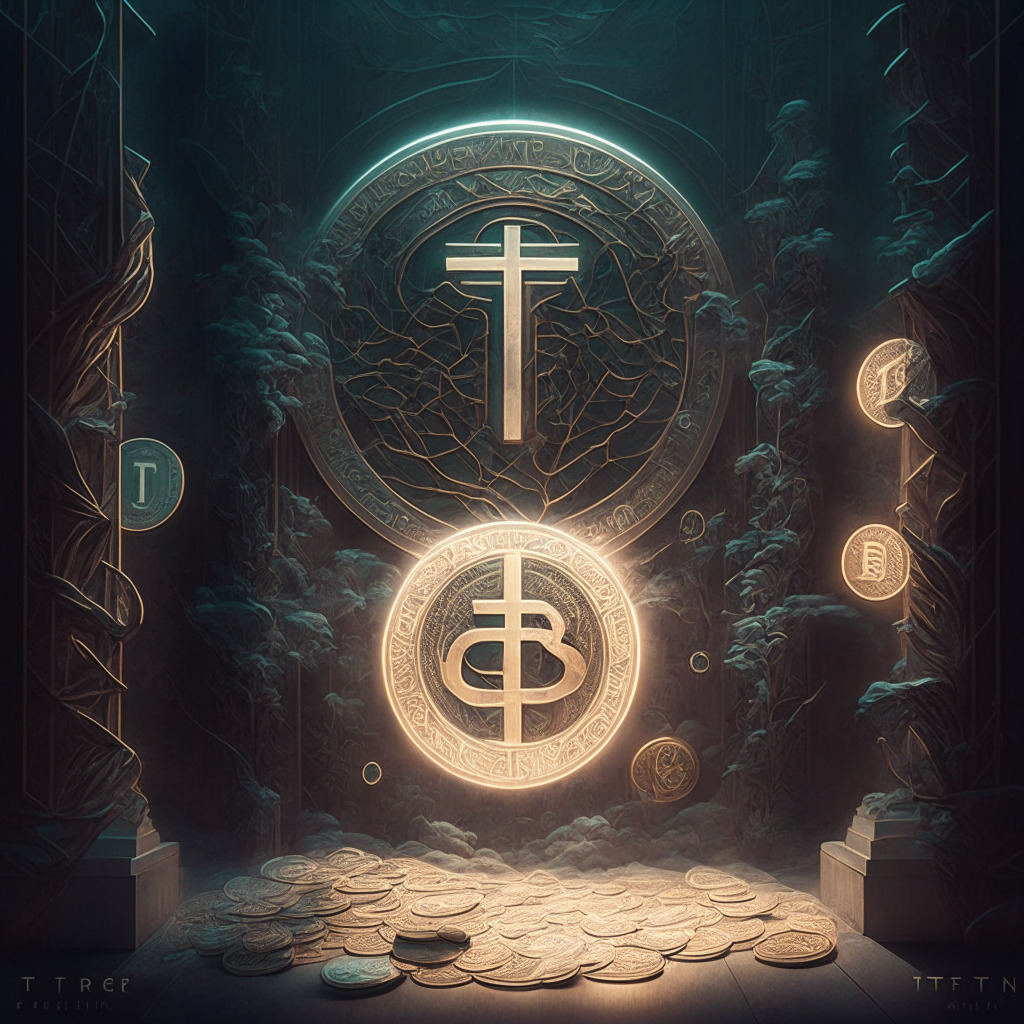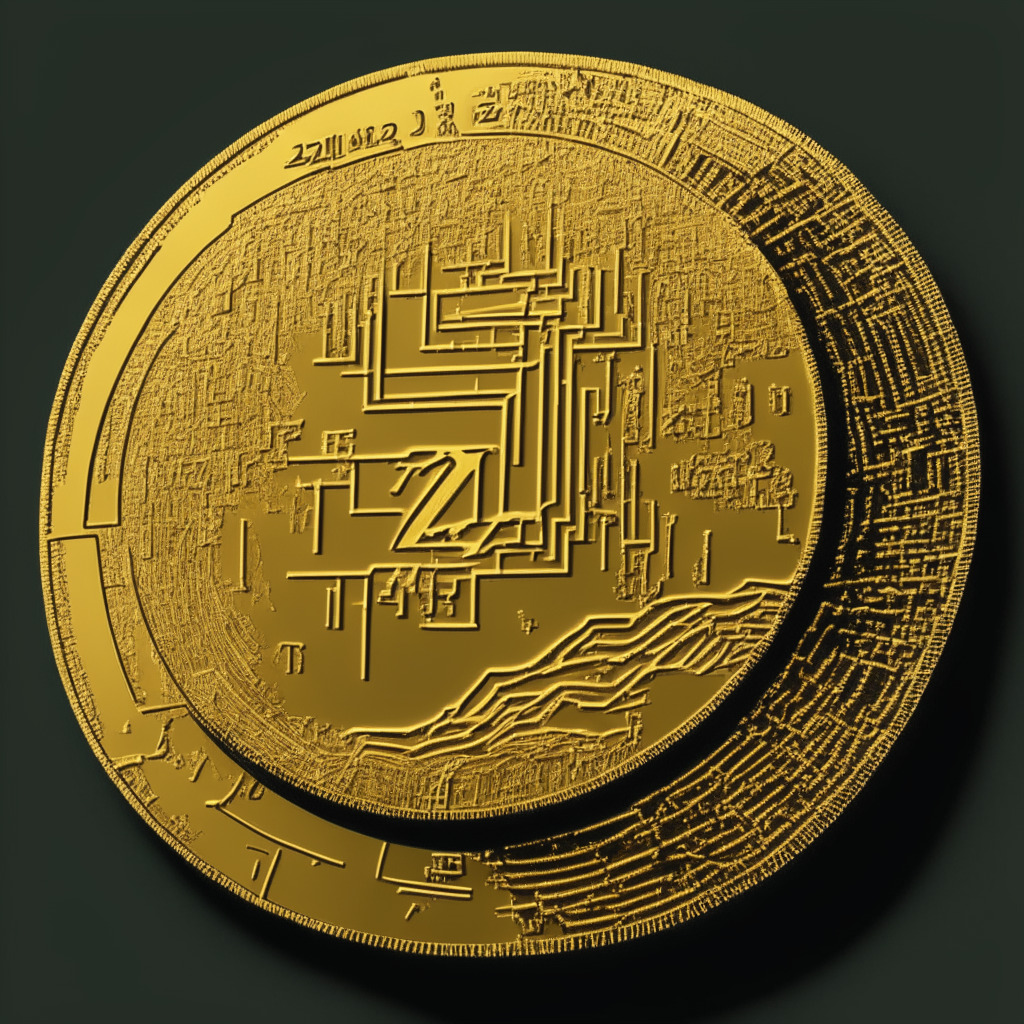The recent arrest of Trust Reserve team in China, the company behind two stablecoins backed by CNY and HKD, has stirred the crypto community. This event, which might be linked to China’s CBDC crackdown, highlights the importance of e-CNY and raises questions on China’s cryptocurrency regulation approach.
Search Results for: Trust Reserve
Tether’s Soaring Reserves: Sign of Trust or Reminder of Controversies?
Tether Holding Limited reported a significant increase in reserves, reaching an all-time high of $2.44 billion in Q1 2023. Despite past controversies surrounding transparency, Tether has enhanced efforts to provide regular attestations and maintain stability, emphasizing the importance of thorough market research before investing in cryptocurrencies.
Understanding the Dark Winter of Bitcoin: Waning Interest, Trust, and Transparency Concerns
Daily Bitcoin trading volumes have notably decreased, similar to 2018’s lows, as per CryptoQuant data. Prevailing uncertainty, partly from the US Central Bank’s interest rate actions, is spurring a Bitcoin holding trend. Despite challenges, the resolute belief in blockchain and cryptocurrencies reflects the crypto ecosystem’s resilience and adaptability.
FTX’s New Liquidation Plan: Strategy to Offload $3.4B Crypto Reserves Amid Bankruptcy Proceedings
FTX, a well-known cryptocurrency exchange, has revised its plan for liquidating $3.4 billion in crypto reserves in response to objections from the U.S Trustee. Their strategy, which removes the requirement for advanced public notice, aims to prevent market volatility from large-scale sell-offs. The plan allows up to $100 million in weekly sales, and includes detailed monthly reports for increased transparency. Currently, the portfolio includes Solana, Bitcoin, and XRP tokens, and will be administered under the supervision of Galaxy Digital’s Mike Novogratz.
Tether’s Booming Stablecoin Reserves: Strategic Masterstroke or Future Liability?
Tether, a recognized stablecoin issuer, saw its reserves surge to $3.3 billion in Q2 2023, showing strategic asset management. The company also reported a 30% quarterly profit increase with earnings exceeding $1 billion. Their portfolio includes other stablecoins and the recent success signifies viable long-term strategies, prompting confidence within the crypto community.
Tether’s Billion-Dollar Profits vs. Transparency Concerns: The Trust Deficit Dilemma in Crypto Markets
“Tether, the issuer of the USDT stablecoin, announced over $3.3 billion in reserve assets and $72.5 billion exposure to U.S. Treasuries in its Q2 attestation. The firm’s operational profits surpassed $1 billion, increasing its Bitcoin holdings to $1.67 billion. However, despite enticing figures, Tether’s opacity raises scepticism regarding its reserve management.”
Bitget’s Staggering $1.44 Billion Reserve Ratio: Financial Fortitude or Overcautious Strategy?
Crypto exchange Bitget declares a debt-free status and remarkable reserves totalling $1.44 billion, exceeding the industry-standard backing with a reserve ratio of 223%. Built through transaction fee profits and returns from investments, Bitget seeks to maintain transparency and reinforce trust by issuing monthly proof-of-reserve statements. The exchange also initiates a crypto lending program, enabling users to maximize investment possibilities.
Chainlink’s Proof-of-Reserves: True Transparency or Illusion of Accountability?
Chainlink’s proof-of-reserves service promises to allow crypto custodians to directly monitor real-world assets on blockchains, increasing safety and transparency for DeFi users. However, the durability of this solution is questioned as the credibility of data depends on the source, possibly masking inadequate accounting practices and reinforcing trust issues in centralized entities.
TrueUSD Under Attack: Prime Trust Insolvency Sparks Short Frenzy and Skepticism
After Prime Trust insolvency, traders are shorting stablecoin TrueUSD (TUSD) despite TUSD denying exposure to Prime Trust. TUSD’s Curve Pool reserves hit 61% and short bets continue to rise. Investors must carefully assess risks surrounding TUSD’s connection to Prime Trust and its ability to maintain its $1 peg before making decisions.
Tether and Kava Partnership: Stablecoin Expansion Amid Reserve Concerns
Tether plans to launch USDT tokens on Kava, a scalable layer-1 blockchain, providing Kava’s community access to the dependable stablecoin. Despite concerns about USDT’s stability and reserves, this partnership strengthens Tether’s position as a market-leading stablecoin.
Restoring Trust in Crypto Lending: Tether’s Response to FTX Collapse & Media Skepticism
The FTX exchange collapse has spurred fear and uncertainty in the crypto community. Facing this challenge, Tether, the largest stablecoin issuer, aims to restore consumer faith by ceasing lending from its reserves and emphasizing fully-collateralized loans backed by liquid assets.
Championing Crypto’s Core Values to Rebuild Trust and Counter Regulatory Challenges
The cryptocurrency community faces regulatory challenges and public perception issues, requiring urgently to share its story and purpose. Stakeholders in crypto, including developers, investors, and government officials, address topics like regulation, privacy, and the future of crypto media in the Consensus 2023 event to restore trust and demonstrate the industry’s core values.
Debt Ceiling Turmoil: Eroding Trust in USD and Bitcoin’s Journey as Safe-Haven Asset
Blackrock CEO Laurence Fink suggests that the US debt ceiling turmoil has eroded global trust in the dollar, potentially benefiting Bitcoin as a hedge against inflation and debt. Market analysts note Bitcoin’s utility as a finite-supply safe-haven asset, but caution that its future value remains uncertain due to market factors and ongoing events.
Tether Boosts Reserves with Bitcoin: Bold Move or Risky Strategy?
Tether plans to strengthen its reserves by investing in Bitcoin (BTC), moving away from US-based government debts. The stablecoin issuer will regularly allocate up to 15% of its net realized operating profits towards purchasing Bitcoin, citing its limited supply, decentralized nature, and widespread adoption as key factors for the decision. Tether’s approach is similar to Microstrategy’s strategy of replacing the U.S. dollar with Bitcoin in its reserves.
The Need for Regulating Crypto Custodians: Safeguarding Digital Assets and Building Trust
A robust regulatory framework specifically designed for custodians is crucial in the evolving cryptocurrency industry. Custodians mitigate risks by safeguarding digital assets, separating them from exchanges. Governments must establish transparent rules enabling custodians to operate legally, ensuring investor protection and a secure ecosystem.
Cryptocurrency Exchange Transparency: Ensuring Trust and Security in the Age of DeFi
The recent crash of FTX, a popular cryptocurrency exchange, highlights the importance of transparency and security in centralized exchanges (CEXs). To ensure asset safety, traders should consider factors such as regular audits, open communication, key metrics, security measures, and platform history and reputation when selecting a CEX.
Global Currency Shift: US Dollar’s Disproportionate Power and the Future of Reserve Currencies
Recent comments by Uday Kotak, CEO of India’s Kotak Mahindra Bank, have drawn attention to […]
Ethereum Rivals Visa, Tether Hits Highs, and Global Crypto Trends: A Weekly Roundup
This week, Ethereum’s transaction volume rivaled Visa, Tether’s market cap hit a record high, and an Ethereum ICO wallet resurfaced with $15 million. Binance dominated headlines with trading discounts and privacy coin delisting news, while CBDC discussions, crypto regulations, and global partnerships shaped the future of the industry.
Multichain Drama: Arrest Rumors, Locked Servers, and Suspended Services Unravel Crypto Startup
Crypto startup Multichain faces challenges after rumors of team members’ arrests and loss of communication with their CEO, Zhaojun. With affected cross-chain services, uncertainty surrounds users’ fund accessibility and private key control. Connection to recent arrests in China remains unconfirmed.
Tether Integration in Private Banks: New Era, Partnerships, and Global Adoption Challenges
The integration of Tether payment rails by Xapo Private Bank marks a new era, providing an alternative to SWIFT rails and showcasing stablecoins’ prominence in the financial sector. Blockchain adoption is recommended for India’s banks, while Binance explores partnerships with traditional financial institutions, and Layer 1 blockchain XDC Network partners with SBI VC Trade Co. Ltd.
Detainment of CNHC and HKDC Stablecoin Team: Navigating Blockchain’s Regulatory Complexities
The detainment of the stablecoin team behind CNHC and HKDC by Shanghai police raises concerns about the future of stablecoins and their standing within regulatory frameworks, highlighting ongoing tension between centralized financial oversight and decentralized cryptocurrency systems. The contrasting regulatory stances between China and Hong Kong reveal a larger issue that investors face when navigating the digital currency landscape.
Gold Versus GambleFi: The Battle for a Safe Haven in Uncertain Economic Times
In the midst of global economic uncertainty, gold’s reliability shines while a gold token, XAUT, experiences a market rise implying a bullish sentiment. Emerging prospects like the TG.Casino, a GambleFi project, blending blockchain’s decentralised advantages with casino gaming, are gaining traction.
Unwrapping the Saga of Alameda’s USDT Mints & Zimbabwe’s Gold-Backed ZiG Tokens
“Alameda Research has minted over $38 billion in Tether (USDT) tokens in 2021, indicating that the total value of USDT creation surpasses Alameda’s total assets. The inner workings of this process involve benefiting from trade value discrepancies and ensuring USDT’s dollar peg stability. However, this raises ethical concerns for industry watchers.”
Bitcoin’s Resistance at $28K: A Market Hurdle or Prelude to a Surge? Plus, The Dark Shadows in Crypto Exchanges
In the Bitcoin market, $28K stands as a significant resistance level that lacks the robust bid needed for conversion to support. Amid global unrest, optimistic forecasts suggest Bitcoin surpassing $30K. Blockchain industry trustworthiness is questioned following allegations of investor fraud against a prominent cryptocurrency exchange’s former CEO. Notably, the crypto world’s decentralized nature doesn’t fully shield it from unscrupulous practices.
Canadian Securities Administrators Unveil Interim Framework for Stablecoin Issuers: Ensuring Safety or Stifling Creativity?
“The Canadian Securities Administrators (CSA) has unveiled a framework to guide exchanges and issuers of stablecoins, aiming to enhance transparency and trust. The rules require stablecoin issuers to maintain sufficient reserves with a qualified custodian and disclose crucial platform information, underscoring the need for investor information and protection.”
Navigating Bitcoin’s Tough Road to $30,000: Exploring the Underlying Challenges
Bitcoin’s struggle to surpass $28.5K is attributed to factors such as failed launch of Ether futures ETFs, US Federal Reserve’s economic concern, a dip in Bitcoin’s core trading metrics, and dwindling faith in the prospect of a spot Bitcoin ETF. The path towards $30,000 appears uncertain.
Introducing DRAM: Dirham-Backed Stablecoin Aims for Global Impact Amidst Regional Restrictions
Swiss company DTR presents a Dirham-supported stablecoin, DRAM, aiming to facilitate global value transfer. Despite its non-availability in UAE and Hong Kong, the token, developed by Dram Trust is listed on decentralized exchanges like Uniswap, PancakeSwap trading with Binance Coin.
Rising Tides: SPX6900 Token Soars Amidst Uncertainty, But Is Meme Kombat The Better Bet?
“SPX6900, named after the SPX index, is gaining substantial traction in the crypto market. Despite the prevailing uncertainty in financial markets, it has proved tantalizing for crypto traders. Meanwhile, Meme Kombat, a blend of gaming and decentralized Web3 platform, is also emerging as a promising contender. With transparent, AI-driven experiences, it’s capturing investor attention. However, as always, prudence is crucial in high-risk crypto trading.”
Decoding the Vaults: Immunefi’s On-Chain Bug Bounty System and Its Possible Pitfalls
Immunefi, a blockchain security platform, has launched its on-chain system for bug bounties named “Vaults”. The system incentivizes white hat hackers by showcasing funds reserved for bounty payments, intending to receive quality bug reports. Despite the potential for slowing processes and unveiling security risks, benefits include enhanced trust-building and streamlined payments.
Venezuela’s Crypto Regulator Shutdown: Breaking Down the Chaos and Predicting Future Fallout
“In an unexpected development, Venezuela has extended the reorganization shutdown of its crypto regulatory body, Sunacrip, due to a corruption scandal. This has left the nation’s crypto market unstable, highlighting the crucial role of transparent and responsible regulatory institutions in maintaining market stability and investor confidence.”
Navigating the Crypto Marker Rollercoaster: Tides of Favorable Occurrences and Forecasted Fluctuations
“Bitcoin continues to steady over $26,200, expected to fluctuate due to federal interest hikes and market changes. Encouragingly, MicroStrategy’s acquisition of 5,400 bitcoins signals racing confidence within the digital currency market. Meanwhile, Lebanon turns to Bitcoin amidst ongoing economic turmoil.”
Resilience in Cryptocurrency: The Curious Case of Rising Stablecoin Loans by Tether Despite Planned Elimination
“In an intriguing move, Tether has seen a rise in stablecoin loans despite an earlier announcement to eliminate these. The reason being short-term loan requests from long-standing clients. Transparency issues have arisen, however, Tether defends the over-collateralization of these loans while gaining market dominance and profit. This venture provides lessons on cryptographic money lending.”































